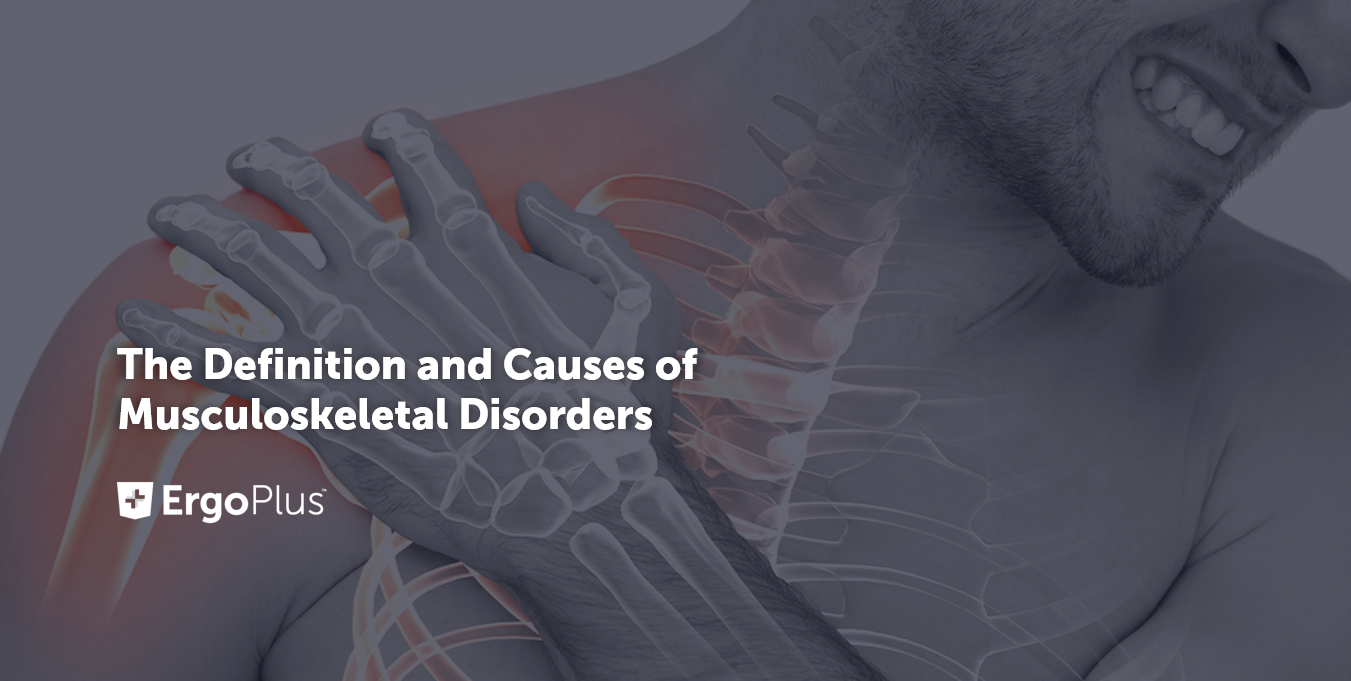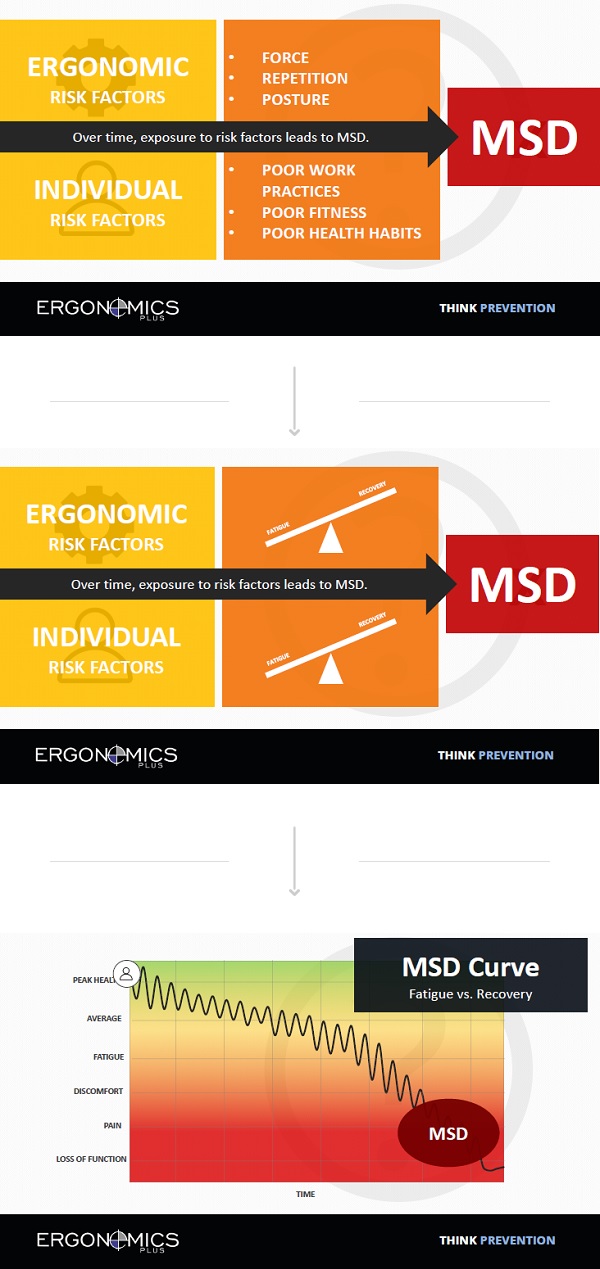Musculoskeletal Disorders (MSDs) are a common and costly problem for people and companies across the United States.
- MSDs are the single largest category of workplace injuries and are responsible for almost 30% of all worker’s compensation costs. (source: BLS)
- U.S. companies spent 50 billion dollars on direct costs of MSDs in 2011. (source: CDC)
- Indirect costs can be up to five times the direct costs of MSDs. (source: OSHA)
- The average MSD comes with a direct cost of almost $15,000. (source: BLS)
The economic and human costs of MSDs are unnecessary. Musculoskeletal disorders are preventable.
To lay the foundation for an MSD prevention strategy, it’s important to understand what MSDs are and what causes them. With this knowledge, you’ll be able to allocate your time, attention and resources most effectively to prevent MSDs.
Definition of Musculoskeletal Disorder
So what is a musculoskeletal disorder?
It’s simple.
Musculoskeletal Disorders or MSDs are injuries and disorders that affect the human body’s movement or musculoskeletal system (i.e. muscles, tendons, ligaments, nerves, discs, blood vessels, etc.).
Common musculoskeletal disorders include:
- Carpal Tunnel Syndrome
- Tendonitis
- Muscle / Tendon strain
- Ligament Sprain
- Tension Neck Syndrome
- Thoracic Outlet Compression
- Rotator Cuff Tendonitis
- Epicondylitis
- Radial Tunnel Syndrome
- Digital Neuritis
- Trigger Finger / Thumb
- DeQuervain’s Syndrome
- Mechanical Back Syndrome
- Degenerative Disc Disease
- Ruptured / Herniated Disc,
- and many more.
We use the term “musculoskeletal disorder” because it accurately describes the problem.
Other common names for MSDs are “repetitive motion injury”, “repetitive stress injury”, “overuse injury” and many more. The problem with using that kind of terminology is that it implicates a singular cause for damage to the musculoskeletal system – repetition and stress. This is limiting because more and more research is pointing to multiple causative risk factors leading to MSDs.
Interested in learning how to prevent common and costly MSDs? Get instant access to our free MSD Prevention 101 training course. Click here to sign up today.
The Cause of Musculoskeletal Disorders – Exposure to Risk Factors
When a worker is exposed to MSD risk factors, they begin to fatigue. When fatigue outruns their body’s recovery system, they develop a musculoskeletal imbalance. Over time, as fatigue continues to outrun recovery and the musculoskeletal imbalance persists, a musculoskeletal disorder develops.
These risk factors can be broken up into two categories: work-related (ergonomic) risk factors and individual-related risk factors.
So the root cause of MSDs is exposure to MSD risk factors – both work-related risk factors and individual-related risk factors.
Work-related Risk Factors
Workplace design plays a crucial role in the development of an MSD.
When a worker is asked to do work that is outside his body’s capabilities and limitations, he is being asked to put his musculoskeletal system at risk. In these situations, an objective evaluation of the workstation design tells us the worker’s recovery system will not be able to keep up with the fatigue that will be caused by performing the job. The evaluation will tell us that ergonomic risk factors are present, the worker is at risk of developing a musculoskeletal imbalance and a musculoskeletal disorder is an imminent reality.
There are three primary ergonomic risk factors.
- High task repetition. Many work tasks and cycles are repetitive in nature, and are frequently controlled by hourly or daily production targets and work processes. High task repetition, when combined with other risks factors such high force and/or awkward postures, can contribute to the formation of MSD. A job is considered highly repetitive if the cycle time is 30 seconds or less.
- Forceful exertions. Many work tasks require high force loads on the human body. Muscle effort increases in response to high force requirements, increasing associated fatigue which can lead to MSD.
- Repetitive or sustained awkward postures. Awkward postures place excessive force on joints and overload the muscles and tendons around the effected joint. Joints of the body are most efficient when they operate closest to the mid-range motion of the joint. Risk of MSD is increased when joints are worked outside of this mid-range repetitively or for sustained periods of time without adequate recovery time.
Exposure to these workplace risk factors puts workers at a higher level of MSD risk. It’s common sense: high task repetition, forceful exertions and repetitive/sustained awkward postures fatigue the worker’s body beyond their ability to recover, leading to a musculoskeletal imbalance and eventually an MSD.
Evidence Base of Work-Related Risk Factors:
Musculoskeletal Disorders and Workplace Factors
NIOSH / U.S. Department of Health & Human Services
The conclusion of this 590 page report is simple and straightforward:
“A substantial body of credible epidemiologic research provides strong evidence of an association between MSDs and certain work-related physical factors when there are high levels of exposure and especially in combination with exposure to more than one physical factor (e.g., repetitive lifting of heavy objects in extreme or awkward postures [Table 1]).
The strength of the associations reported in the various studies for specific risk factors after adjustments for other factors varies from modest to strong. The largest increases in risk are generally observed in studies with a wide range of exposure conditions and careful observation or measurement of exposures.”
Work-related Musculoskeletal Disorders: The Epidemiologic Evidence and the Debate
Journal of Electromyography and Kinesiology
“Thus there is an international near-consensus that musculoskeletal disorders are causally related to occupational ergonomic stressors, such as repetitive and stereotyped motions, forceful exertions, non-neutral postures, vibration, and combinations of these exposures.”
Additional reading:
- Association of Occupational and Non-occupational Risk Factors with the Prevalence of Musculoskeletal Disorders
- Work-related Musculoskeletal Disorders (WMSDs): An Introduction
Individual-related Risk Factors
Human beings are multi-dimensional. Limiting ourselves to a singular cause of MSDs will limit our ability to create a prevention strategy that addresses the multi-dimensional worker.
We need to address both workplace risk factors and individual risk factors.
Individual risk factors include:
- Poor work practices. Workers who use poor work practices, body mechanics and lifting techniques are introducing unnecessary risk factors that can contribute to MSDs. These poor practices create unnecessary stress on their bodies that increases fatigue and decreases their body’s ability to properly recover.
- Poor overall health habits. Workers who smoke, drink excessively, are obese, or exhibit numerous other poor health habits are putting themselves at risk for not only musculoskeletal disorders, but also for other chronic diseases that will shorten their life and health span.
- Poor rest and recovery. MSDs develop when fatigue outruns the workers recovery system, causing a musculoskeletal imbalance. Workers who do not get adequate rest and recovery put themselves at higher risk.
- Poor nutrition, fitness and hydration. For a country as developed as the United States, an alarming number of people are malnourished, dehydrated and at such a poor level of physical fitness that climbing one flight of stairs puts many people out of breath. Workers who do not take care of their bodies are putting themselves at a higher risk of developing musculoskeletal and chronic health problems.
Exposure to these individual risk factors puts workers at a higher level of MSD risk. Just like workplace risk factors, individual risk factors are common sense: when a worker uses poor work practice, has bad health habits, doesn’t get adequate rest and recovery and doesn’t take care of their bodies with a good nutrition and fitness regimen, they are at greater risk for fatigue to outrun their recovery system. Having a poor overall health profile puts them at greater risk of developing a musculoskeletal imbalance and eventually an MSD.
Not convinced? Here is what the scientific literature has to say.
Evidence Base of Individual-related Risk Factors:
NIOSH Total Worker Health
NIOSH
NIOSH supports a multi-dimensional view of workers, which they call “Total Worker Health”. This strategy integrates health protection with health promotion because they recognize that, “emerging evidence recognizes that both work-related factors and health factors beyond the workplace jointly contribute to many health and safety problems that confront today’s workers and their families.”
“Total Worker Health is a strategy integrating occupational safety and health protection with health promotion to prevent worker injury and illness and to advance health and well-being.”
Here is a quote from the NIOSH Total Worker Health Seminal Research Papers (2012):
“Today, emerging evidence recognizes that both work-related factors and health factors beyond the workplace jointly contribute to many health and safety problems that confront today’s workers and their families. Traditionally, workplace health and safety programs have been compartmentalized. Health protection programs have focused squarely on safety, reducing worker exposures to risk factors arising in the work environment itself. And most workplace health promotion programs have focused exclusively on lifestyle factors off-the-job that place workers at risk. A growing body of science supports the effectiveness of combining these efforts through workplace interventions that integrate health protection and health promotion programs.”
Work-related Musculoskeletal Disorders: Prevention report
European Agency for Safety and Health at Work
“Epidemiological studies have shown that some personal risk factors for MSDs such as smoking, being overweight, or in poor physical shape are the same factors as those relating to poor general health. Therefore general health promotion at the workplace might be one option to prevent MSDs.”
“Practice shows that the collaboration of people with expertise in different areas (e.g. engineering, psychology, human relations) is advantageous as this allows MSD-related issues to be approached in a global way. However, the involvement and participation of all employees and their representatives is crucial to success in such a holistic approach and, moreover, in creating a culture where ergonomics and the prevention of musculoskeletal disorders is embedded in every part of the process.”
Work-related Musculoskeletal Disorders Assessment and Prevention
InTech
“The recognition of personal risk factors can be useful in providing training, administrative controls, and awareness. Personal or individual risk factors can impact the likelihood for occurrence of a WMSD (McCauley-Bell & Badiru, 1996a; McCauley-Bell & Badiru, 1996b). These factors vary depending on the study but may include age, gender, smoking, physical activity, strength, anthropometry and previous WMSD, and degenerative joint diseases (McCauley Bush, 2011).” …
Besides risk factors related to work other risk factors contribute to its development, namely factors intrinsic to the worker and factors unrelated to work. A risk factor is any source or situation with the potential to cause injury or lead to the development of a disease. The variety and complexity of the factors that contribute to the appearance of these disorders explains the difficulties often encountered, to determine the best suited ergonomic intervention to be accomplished in a given workplace, to control them. Moreover, despite all the available knowledge some uncertainty remains about the level of exposure to risk factors that triggers WMSD. In addition there is significant variability of individual response to the risk factors exposure. The literature review and epidemiological studies have shown that in the genesis of the WMSD three sets of risk factors can be considered (Bernard, 1997; Buckle & Devereux, 1999; Nunes, 2009a): Physical factors – e.g., sustained or awkward postures, repetition of the same movements, forceful exertions, hand-arm vibration, all-body vibration, mechanical compression, and cold; Psychosocial factors – e.g., work pace, autonomy, monotony, work/rest cycle, task demands, social support from colleagues and management and job uncertainty; Individual factors – e.g., age, gender, professional activities, sport activities, domestic activities, recreational activities, alcohol/tobacco consumption and, previous WMSD.”
Work-related Musculoskeletal Disorders: The Epidemiologic Evidence and the Debate
Journal of Electromyography and Kinesiology
“As with most chronic diseases, MSDs have multiple risk factors, both occupational and non-occupational. In addition to work demands, other aspects of daily life, such as sports and housework, may present physical stresses to the musculoskeletal tissues. The musculoskeletal and peripheral nerve tissues are affected by systemic diseases such as rheumatoid arthritis, gout, lupus, and diabetes. Risk varies by age, gender, socioeconomic status, and ethnicity. Other suspected risk factors include obesity, smoking, muscle strength and other aspects of work capacity.”

